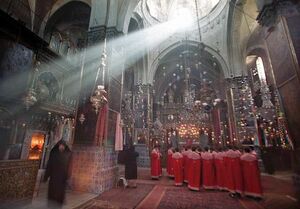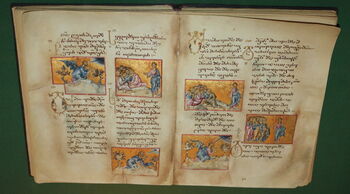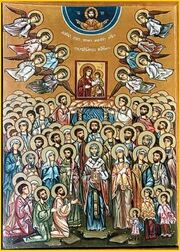| Hobrazian Orthodox Church ჰობრაცური მართლმადიდებელი ეკლესია Հոբրէ Շլիհըէ Գրշյոգըդ | |
|---|---|
 | |
| Type | Patriarchal |
| Theistic philosophy | Unitarian |
| Scripture | Hosian Bible |
| Governance | Episcopal |
| Patriarch | Iakob VII |
| Region | Hobrazia |
| Headquarters | Astoria |
| Founder | Saint Thomas |
| Founded | 1st to 5th century in Hobrazia |
| Recognition | Apostolic Church of the East |
| Liturgical language | Hobrazian |
| Liturgical rite | Hobrazian |
| Members | 11 million |
The Hobrazian Orthodox Church (Hobrazian: ჰობრაცური მართლმადიდებელი ეკლესია; Hobratsuri Mart’lmadidebeli Eklesia, Pntek: Հոբրէ Շլիհըէ Գրշյոգըդ Hobré Shlihaé Grshjogad) is a major Hosian church within the Eastern Patriarchal tradition.
In addition to being the national church of the Hobrazian people, it has retained a historic influence over Pntek and Zargundian Hosians. The Hobrazian Church is one of the oldest Hosian institutions in the world and is said to have been founded by the Saint Thomas. Having rejected the Council of Auroria in 533, it is part of the Apostolic Church of the East.
Existing for many centuries as an independent eastern Hosian church, the Synod of Aldegaria in the 35th century returned to the Hobrazian Church into full communion with the other major eastern churches collectively known as the Patriarchal Church (Eastern Rite).
At this time with the foundation of the Apostolic Church of the East, the Patriarch of Hobrazia became the first among the Eastern Patriarchs. Alongside various other small changes the Synod of Qart Qildar elevated the Patriarch of Qart Qildar to this position.
Overview[]
Like other Patriarchal churches, the Hobrazian Orthodox Church considers itself to to be the continuation of the original Church established by Eliyahu during his time on the world according to the principle of apostolic succession.
Unlike the Aurorian and Terran Patriarchal churches, the Hobrazian Church and the other particular churches of the Apostolic Church of the East reject the binitarian theology established at the Council of Auroria. According to the doctrine of the eastern churches, there is one God and he is not composed of multiple persons. The eastern church teaching on this matter is expressed in the official Creed adopted at the Synod of Qart Qildar:
We, following the Holy Fathers, all with one consent, teach men to confess One God, eternal, uncreated, and unbegotten, Father of us all, Who is fully transcendental and beyond comprehension, and One Spirit, Who is the Wisdom, the Mind, the Power, and the Light of God, of the same Being and Person as God, preexistent with Him and Who created the whole creation [...]
In comparison to the western churches, the Hobrazian Church adopts a different understanding of the divinity of Eliyahu too. Emphasising his humanity they do not believe there is a substantial difference between the Spirit's incarnation in him and the union that all faithful share with God through his Spirit.
Throughout the history of Hobrazia the Church has experienced a troubled and at times actively hostile relationship with the form of Hobrazian paganism known as Hobaism. Hobaists have traditionally adopted a fiercely evangelical approach to converting Hosians while Hosians have at times engaged in the active repression of Hobaism.
In the modern era the Hobrazian Church is organised into five major dioceses that reflect the five historical regions of Hobrazia. Outside of the country there are a variety of smaller dioceses that primarily service the Hobrazian diaspora community. Key among these are those in Luthori, Malivia as well as Narikaton and Darnussia.
The spiritual leader of the Hobrazian Church is the Archbishop of Astoria, who is known as the Patriarch of Hobrazia. In addition to leading the Hobrazian Church, they also previously served as the first among equals of the patriarchs of the Apostolic Church of the East until the Synod of Qart Qildar elevated the Patriarch of Qart Qildar to the primacy of honour.
History[]
In terms of historical facts very little is known about the foundation and early years of the Hobrazian Church. According to doctrine and popular belief, Saint Thomas the Believer first brought Hosianism to the region and founded the Church in the first millennia. The teaching of the Church is that he was martyred for his mission in Hobrazia and this is something that has been a source of historic tension between Hosians and Hobaists in Hobrazia.
Due to geographical proximity to Majatra, particularly Beiteynu and Selucia, Hobrazia became an important centre of the early Hosian community and acted as a gateway for the faith to spread into northern Artania and from their throughout the rest of the world.
In the fifth century, the Annuciation was among the first texts to be written in the Hobrazian language. Despite a spoken language having existed for centuries, the development of a distinct Hobrazian alphabet (unrelated to the Selucian or Kalopian alphabets) is regarded as an important moment in the history of the faith and the Hobrazian people, having provided a central focus for national identity for millennia since.

Inside a Hobrazian Orthodox Church
Council of Auroria[]
In 533, the heads of all local Hosian churches were convened in Auroria by the Patriarch of Selucia, in order to end the disagreements between the numerous independent churches. This resulted in the Council of Auroria, which decided to adopt a single doctrine and church structure for the whole Hosian world. The Hobrazian Church, represented by Saint Evdemoz, was the only one to reject the council, resulting in the first major Hosian schism.
Patriarchal Church (Eastern Rite)[]
The Hobrazian Orthodox Church became actively involved in missionary activity beginning with the seventh century, spreading through most of Northern Majatra, Seleya, and Eastern Artania. This led to the establishment of several subordinate churches, the most important one being the Al'Badaran Patriarchal Church. In time, contact between the Hobrazian Orthodox Church and the other Eastern churches was lost during the subsequent invasions, leading to the formation of the Patriarchal Church (Eastern Rite). The Hobrazian Orthodox Church still considers the Patriarchal Church (ER) to be a legitimate offshoot, albeit affected by dogmatic errors.
Modern day[]
In 3412, following the Synod of Aldegaria, the Church reunited with the Patriarchal Church (Eastern Rite) to form the Apostolic Church of the East.
Beliefs[]
Eliyahu[]
The Hobrazian Orthodox Church follows mainstream Hosian doctrine, believing that Eliyahu is an emanation of Lord Hoba (the Hobraian name for God), the "Spirit of God", through whom he created Terra. The Church believes that Eliyahu did not die, but is alive in Heaven in Hiding. He will return when Terra is ready, and establish his Kingdom. It is believed that Eliyahu's mission on Terra included giving people his word and example to follow, as recorded in the Annunciation. Hobrazian Orthodoxy believes that the main role of Eliyahu is to act as an intermediary between God and man. Since man cannot know God or experience his graces directly, it is through the means of the Spirit of God that one may partake in the divine nature.

Medieval copy of the Annunciation
Sin and Salvation[]
Progress toward salvation is accomplished in the earthly life only by God's grace, with which man must freely cooperate. The free cooperation of man includes prayer, asceticism, participation in the sacraments, following the commandments of Eliyahu, and above all, repentance of sin. Salvation is thus for the whole human person, involving both the body and the soul.
Union with God[]
The main focus of the Hobrazian Orthodox Church is the union of the individual with God. Hobrazian Orthodox Hosians believe that through prayer and asceticism one may take part in the nature of God, not directly, but through the mediation of the Spirit of God. The Hobrazian Orthodox Church does not believe that this union cancels the individuality of the person praying, or their human nature, but that the person remains fully human, and in full communion with the divine. The traditional metaphor used to explain this concept was that of metal placed in flames, which retains its nature, but partakes in the nature of fire. It is considered that this Union is the highest goal in the Hosian life, and to strive to achieve it is the duty of every Orthodox faithful.

Hobrazian icon representing the continuous revelation offered to the Church Fathers
Annunciation and Continuous Revelation[]
Although it rejects the Council of Auroria, which defined the Hosian scriptural canon, the Hobrazian Orthodox Church generally uses the same holy books as the other Hosian churches. The Church does, however, reject any attempt to limit the biblical canon, or establish any distinction between scripture and tradition. To do so, the Church believes, is to take the Scriptures out of context, and to deny the ability of God's Spirit to continue to inspire after the completion of the Holy Books. Instead, the Orthodox believe that Eliyahu constantly works to illuminate the Fathers of the Church, just as He illuminated the biblical prophets, and that divine revelation is continuous.
Sacrifices[]
- Baptism (Sacrifice of Water)
- Revelation (Sacrifice of Gratitude): equivalent of the Eucharist
- Illumination (Sacrifice of Light): similar to confirmation
- Vocation (Sacrifice of Piety): consecration of priests
- Monasticism (Sacrifice of Solitude)
- Marriage (Sacrifice of Love)
- Remission (Sacrifice of Purity): Similar to confession
- Burial (Last Sacrifice, Sacrifice of Memory)
